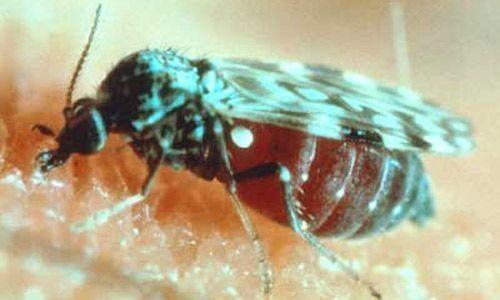Biting Midges - No-See-Ums
We have had a lot of complaints about people here in Benidorm being bitten, the poor mosquito seems to be getting the blame, but at certain times of the year these bites are inflicted by a very small black fly. This fly is part of the Ceratopogonidae family, and due to their small size Biting Midges are commonly known as NO-SEE-UMS. The common problem upon experiencing a bite from this insect is that something is biting, but the person suffering cannot see what it is.
Biting Midges No-See-Ums are sometimes incorrectly referred to as sand flies. Sand flies are insects that belong to a different biological group and should not be confused with the biting midges.
Coastal areas and beaches are among the most common breeding grounds biting midges.

No-see-ums are aptly named since they are so tiny and difficult to spot. If you do happen to catch sight of the bug that bites you, though, it helps to know what you're looking for.
No-see-ums are only about 1/16 inch (1.5 mm) in length. They have wings, but at that size, those wings are hardly visible. At first glance, the insect may look like a flea.
These insects leave bite marks that can be extremely itchy and moderately painful. Thankfully, there are a few ways to treat the bites and soothe your symptoms.
No-see-um bites can also occur indoors if a breeding ground is located nearby outdoors. Keep the season in mind, too. No-see-ums are most active during May and June, when the weather is just beginning to warm up and September/October when its starting to cool down. The problem will usually last for a few weeks before the bugs go away.
Identify the welt.

A no-see-um bite initially appears as a small red dot. This dot can expand into a welt that is 1 to 2 inches (2.5 to 5 cm) in diameter.
When the bug bites, it injects saliva into the skin. This saliva is what causes the welt and the allergic reaction.
Welts usually last for two weeks, give or take a few days.
No-see-um bites are usually very itchy and can become mildly painful.
No-see-ums can bite multiple times and typically feed in large groups, so you'll usually find clusters of bite welts instead individual ones.
Moreover, no-see-ums do not inject you with a numbing agent as they bite, so you will probably feel each bite as it happens.
Most bites occur on the legs, hands, and back of the neck, but any area of exposed skin is a vulnerable point.
HOW TO STOP THEM BITING
Deet or any other repellents do not work on well, but if you do use it make sure you use one containing at least 30 percent DEET (do not use strong Deet based products on young children). Insecticide sprays also seem to have little effect, also try anything Citronella or lemon based or Avon’s Skin-So-Soft and the local Agua de Cologna. Lavender oil is also a repellent for flies. Basically the prevention is more or less the same for these as it is for Mosquitos.
keep as much as your skin covered as possible. Make sure it's not so loose that they can fly into the openings and bite you.
For information on Mosquito repellents etc.
TREATMENT OF BITES
One of the most important things to do when you have a no-see-um bite is to stop yourself from scratching it.
Scratching the welts can cause them to break open. Once a welt breaks open, it is far more likely to become infected.
It's a good idea to keep your fingernails short and clean for the duration of bite. You may scratch the area without thinking, and if dirt and bacteria are trapped beneath your nails, the site can quickly become infected.
Wash with soap and water. As soon as you notice the bite-ridden area, gently wash it with a mild antibacterial soap and warm water.
Washing the area immediately helps reduce the risk of infection. It can also get rid of any residual no-see-um saliva sitting on the surface of your skin, thereby reducing the amount of irritation you'll feel.
Numb the bite. When the bites begin to swell, you can stop the swelling by applying a cold compress or ice pack.
Soak a clean washcloth in cold water and gently press it over the bite area for 10 minutes to reduce initial swelling. To numb pain or more severe swelling, wrap several ice cubes in a clean washcloth and press that against the bite site. You could also use a bag of frozen vegetables. Numb the area in 10 to 15 minute intervals as needed for the first 24 hours.
Apply hot water to each bite. Heat water to an approximate temperature of 180 degrees Fahrenheit (82 degrees Celsius). Dunk the tip of a cotton swab in the water, then apply the scalding water directly over the bite.
This treatment works best for bites that itch but don't hurt.
When you apply the hot water, expect the bite to sting slightly for several seconds. The stinging should stop quickly, however, and the itch should be subdued. Only use this application two or three times per bite.
Never apply scalding water using anything larger than a cotton swab. Too much can cause a burn.
Try a topical analgesic or antihistamine. A standard over-the-counter analgesic cream can usually reduce pain associated with no-see-um bites, while a standard antihistamine can relieve itching. Always follow the package instructions to determine proper application and dosage. Usually, you will need to apply a thin layer of the medication directly over the bite using your fingers.
Use a cream, ointment, or other rub for best results. Sprays are not as effective against insect bite relief.
Counter irritant analgesics may work best for painful bug bite relief. Ingredients in these treatments create a burning or cooling sensation that can distract the mind from the pain caused by the bite. Switch to a cortisone cream. If topical analgesics and antihistamines are not effective, try a cortisone cream, instead.
Cortisone creams tend to be a little stronger than antihistamines and work in a different manner. They essentially block the body from releasing chemicals or activating cells that can worsen itching and swelling.
Follow the package instructions carefully and never apply more than directed.
Use a zinc ointment. Obtain an over-the-counter zinc cream or ointment. Apply the product as directed on the package. Zinc creams are often used against rashes and minor skin irritations. Apply a thin layer directly over the bite and cover the area with a bandage to prevent the cream from getting wiped away. Immediately stop use if your symptoms worsen.
Treat with aloe vera gel. Aloe vera is a natural treatment. The plant possesses qualities that help numb pain and itchiness. Apply a generous amount of aloe vera gel over the entire affected area. It is usually safe to use large quantities of aloe vera, but as always, you should follow the label instructions when applying this treatment.
Consider an oral medication. Topical treatments usually have the highest odds of success, but in some cases, an over-the-counter oral drug might be more effective.
Treat pain and inflammation with a non-steroidal anti-inflammatory drug, like aspirin or ibuprofen.
Use an oral antihistamine to treat itchiness or other signs of mild to moderate allergic reaction, like hives.
Consult a doctor immediately if you have a severe reaction. If you experience an abnormally severe allergic reaction, you might need prescription treatment.
For severe swelling, your doctor may prescribe prescription antihistamines or corticosteroids.
If you experience wheezing, difficulty swallowing, or swelling/itching anywhere else on your body other than the location of the bite, seek emergency medical treatment. Such reactions may need to be treated with an injection of adrenaline or a similar intravenous medication.
Like us on Facebook for regular updates on Biting Midges No-See-Ums or follow us on Twitter



